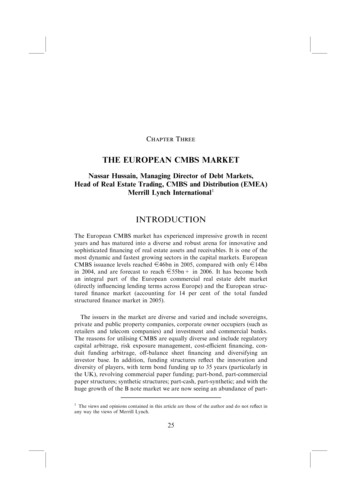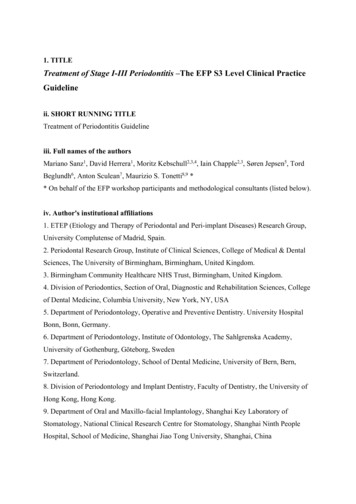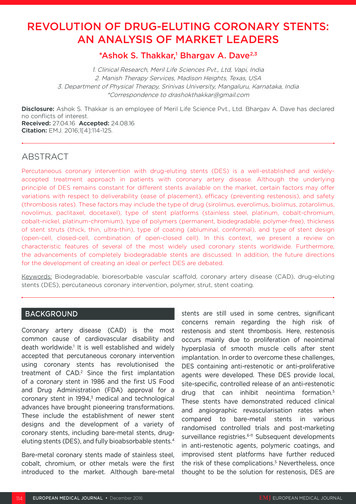
Transcription
Chapter ThreeTHE EUROPEAN CMBS MARKETNassar Hussain, Managing Director of Debt Markets,Head of Real Estate Trading, CMBS and Distribution (EMEA)Merrill Lynch International1INTRODUCTIONThe European CMBS market has experienced impressive growth in recentyears and has matured into a diverse and robust arena for innovative andsophisticated financing of real estate assets and receivables. It is one of themost dynamic and fastest growing sectors in the capital markets. EuropeanCMBS issuance levels reached e46bn in 2005, compared with only e14bnin 2004, and are forecast to reach e55bn in 2006. It has become bothan integral part of the European commercial real estate debt market(directly influencing lending terms across Europe) and the European structured finance market (accounting for 14 per cent of the total fundedstructured finance market in 2005).The issuers in the market are diverse and varied and include sovereigns,private and public property companies, corporate owner occupiers (such asretailers and telecom companies) and investment and commercial banks.The reasons for utilising CMBS are equally diverse and include regulatorycapital arbitrage, risk exposure management, cost-efficient financing, conduit funding arbitrage, off-balance sheet financing and diversifying aninvestor base. In addition, funding structures reflect the innovation anddiversity of players, with term bond funding up to 35 years (particularly inthe UK), revolving commercial paper funding; part-bond, part-commercialpaper structures; synthetic structures; part-cash, part-synthetic; and with thehuge growth of the B note market we are now seeing an abundance of part1The views and opinions contained in this article are those of the author and do not reflect inany way the views of Merrill Lynch.25
The European CMBS Marketbond and part-bank/fund driven lending. In recent times, issuance has beendominated by conduit programmes established by investment banks andother multi-borrower transactions, single borrower issuances by largeproperty companies and sovereign transactions relating to governmentdisposal of real estate (in particular Italy).This chapter will begin with a brief history of the emergence of CMBS inEurope and will then look at various aspects of European CMBS including,key participants, why CMBS is used, CMBS spreads, CMBS issuance,ratings transition, transaction types, transaction motivation, property typesand valuations, legal issues peculiar to the European market and the impactof Basel II.2ORIGINS AND EARLY DEVELOPMENT OFTHE EUROPEAN CMBS MARKETThe European CMBS market developed for very different reasons to the USCMBS market, where it developed and grew as a result of distress in thecommercial real estate market, financial regulatory changes and retrenchment of traditional lenders, as a result of which, borrowers and financialinstitutions turned to the capital markets to raise funds by issuing CMBS.Whilst the initial impetus for CMBS transactions in the US came from theResolution Trust Corporation (‘‘RTC’’)3 (the federal agency responsible forclearing up the savings and loans (thrift) institutions), this was complemented very quickly by private sector issuance especially as the commercial real estate market improved.Whilst the very first real estate capital market transactions in Europe weredeveloped at a time of distress in the UK market, such as the 150m KingsCross House PLC (1989), the number of transactions were very limited andshort-lived as the immense liquidity and relationship-based lending practices, which epitomise the real estate lending arena in Europe, came back tothe forefront. Consequently, many of the deals that followed tended to beopportunistic and, with the development of all new markets, were focusedon the easier jurisdictions and collateral types and typically with only onerating agency involved. In the early 1990s, a number of agented singleborrower deals, secured against Central London offices, and credit tenantleases were completed, including the 120m 135 Bishopsgate Funding (1991)and the 42.3m Grays Inn Road transaction (1992). This pattern was fol2Basel Committee on Banking Supervision: International Convergence of Capital Measurementand Capital Standards: A Revised Framework. June 2004, available at http://www.bis.org/publ/bcbs107.htm.3See Ch.1.26
Origins and Early Development of the European CMBS Marketlowed by subsequent deals such as the 40m Solar transaction (1995)secured against a Central London office building let to the UK Government.The initial multi-borrower deals were driven by balance sheet/capitalmanagement, risk transfer and funding requirements. The very first multiborrower CMBS was completed in the UK in 1993 by UCBH, in a securitisation of a nursing home loan portfolio in the 183m Hog 1 transaction(1993), and similar deals were completed by Citibank under the Sonarprogramme in 1994 and 1995. Bristol & West Building Society completedthe 145.5m UK CLIPS CMBS in 1994 and the United Bank of Kuwaitcommenced the popular Acres programme in 1995, completing three multiborrower CMBS deals including a separate sell-down of the pooled residuals( 109m Acres 1 (1995), 121.3m Acres 2 (1996), and 118m Acres 3 (1997)).The late 1990s saw a number of landmark deals which were to shape theEuropean CMBS market for many years to come with innovative structuring and increased deal sizes. These included the 555m Canary WharfFinance securitisation in 1997, the largest transaction to have been completed to date, which tapped into both the floating rate market and a uniquefeature of the UK market, the long dated fixed rate sterling bond market.The 343.2m CIT transaction in 1997, also secured on offices with credittenants, was the first single-borrower deal to have exposure to refinancingrisk as well as being funded partly in the commercial paper market (seniortranches), with the junior tranches being structured for placement in thebanking market (not dissimilar to the AB structures very common today). In1996 and 1997, the first non-UK CMBS transactions were completed, withseveral transactions being completed in France including the Ffr1.5bnBelenus for UIC-Sofal and the Ffr2bn La Defense transaction, whichsecured office buildings in Paris. The first European conduit programme wasestablished by Morgan Stanley in 1998, with the pioneering 168.9m ELOC1 transaction. Anglo Irish Bank Corporation, shortly thereafter, completedthe first deal in its Monument CMBS programme of highly granular commercial mortgages in the UK, which was driven by capital managementrequirements. 1999 witnessed the first jumbo CMBS transaction in the formof the 1.5bn Broadgate securitisation, a trophy asset securitisation with ahighly innovative security structure driven by compliance with restrictions inthe borrower’s existing corporate bonds/debentures. In 1999 one of the firstsynthetic CMBS transactions was completed by Deutsche Hypothekenbankin relation a pool of second lien commercial rate mortgages (e267mDeutsche Hypothekenbank, Hannover).Examples of some key European CMBS transactions since 2000 includethe following:27
The European CMBS Market. Europa 1 (2000)—one of the first multi-jurisdictional synthetic CMBSin Europe. Global Hotel 1 (2001)—first synthetic CMBS secured on global hotelportfolio. Pan European Industrial Properties 1 (2001)—one of the first multijurisdictional cash CMBS in Europe (UK, Holland and France). SCIP Series—e2.3bn SCIP 1 (2001) sovereign securitisation by ItalianTreasury backed by commercial and residential property followed bye6.6bn SCIP 2 (2002) (refinanced April 05) being one of the largestCMBS transactions to date. Imser Securitisation S.r.l. (2002)—first performing Italian CMBS. Eiger Trust (2003)—first Swiss CMBS. ELOC 17 (2003)—first multi-jurisdictional conduit CMBS. Business Mortgage Finance 1 (2004)—first non-conforming smallcommercial loan CMBS in Europe. Self Storage Securitisation B.V. (2004)—first self storage CMBS inEurope. Land Securities (2005)—quasi corporate/CMBS flexible financingstructure. Taurus 1 CMBS (2005)—first co-pooled conduit CMBS in Europe. Fleet Street Finance 1 (2005)—first securitisation of predominantlyoperating real estate assets to apply CMBS analysis in order to achievesuperior rating levels. Taurus 2 CMBS (2005)—first multi-borrower conduit CMBS in Italy. Real Estate Capital 3 (Foundation) (2005)—one of the most flexibleCMBS transactions to date including securitisation of blind pool ofassets. Forest Finance (2005)—first CMBS in Austria. Opera Finance (CMH) (2006)—first CMBS in Ireland.KEY PARTICIPANTS IN EUROPEAN CMBSIssuersThe issuers are varied and encompass most entities that own real estateassets or some form of direct or indirect real estate risk including corporates(publicly listed and private real estate companies, publicly listed and private28
Key Participants in European CMBScompanies that own real estate (such as retailers and telecom companies),investment banks, commercial banks, mortgage banks, sovereigns, fundsand individuals.Motives. All: cost efficient financing, diversification of funding sources, access toa deep investor base, capacity for much larger deal sizes, enhancedmarket profile, innovative and flexible structuring techniques, strategicfunding tool. Financial institutions: also includes regulatory arbitrage, off balancesheet financing, risk exposure management, improving return onequity, conduit funding arbitrage. Sovereigns: also includes improving sovereign balance sheets and fiscalcredibility. Corporates/Funds: also includes access to longer funding maturities(particularly in the UK), maintain existing banking relationshipsthrough B notes.Rating agencies4The dominant three rating agencies in Europe, Fitch Ratings (acquired Duff& Phelps in 2000), Moody’s Investor Service (‘‘Moody’s’’) and Standard &Poor’s, are all active in rating CMBS transactions in Europe. The analyticalapproach followed by these agencies is varied in relation to modellingmethodology, qualitative analysis and legal and structural analysis and itis not unusual to see split ratings or certain parts of the capital structurewhere not all rating agencies on a deal participate. In the early years of theCMBS market, it was not uncommon for rating analysts to focus on anumber of asset classes, however, with the huge growth of the structuredfinance market and the increased specialisation and sophistication of themarket, each have product teams that specialise in CMBS and, in somecases, country teams (rather than London based) that specialise in CMBSonly in their respective jurisdiction. Moody’s and Standard & Poor’sglobally have the largest market share in the structured finance market andbenefit from many investors such as CP conduits, SIVs and CDOs requiringboth a Moody’s and Standard & Poor’s rating. The notching requirements,in many cases, make its difficult for such investors to invest in bonds withouta Moody’s and Standard & Poor’s rating. Fitch Ratings has sought todifferentiate itself through increased focus on customer service and investoreducation. The estimated market share by volume of these three agencies onEuropean CMBS in recent years has been:4For details of the ratings process within Standard & Poor’s, see Ch. 4.29
The European CMBS Market. Fitch Ratings: 80–90 per cent. Moody’s: 70–90 per cent. Standard & Poor’s: 85–90 per cent.In recent months, the Canadian-based Dominion Bond Rating Servicehas announced plans to enter the European CMBS market and is in theprocess of establishing a team in Europe.InvestorsThe CMBS investor base is diverse and comprises numerous types offinancial institutions including banks, building societies and fund managers,CP Conduits, SIVs, CDOs, insurance companies, pension funds, opportunistic/hedge funds, corporates and in the case of sub-investment grade debteven high net worth individuals.The arguments for CMBS investment relative to other asset classes include:. yield pick compared to consumer finance asset classes;. the capital structure of deals is conservative—credit enhancement forAAA in the region of 25 to 30 per cent on many deals;. many deals have exposure to investment grade tenants—which are asuperior credit to B leverage loan CLOs; and. portfolio granularity can be found in some deals—for example largeshopping centres with a wide range of tenants, business finance dealswith a large number of SME-like borrowers, and even portfolio officedeals with a range of properties, tenants and re-letting options.Many deals are pricing around the recently established benchmark levelsbecause of:. novelty—the first deals from a certain country or property sector;. supply levels; and. analytical complexity for investors to get comfortable with deals.Servicers5The servicer administers the loan or loans secured on the underlying realestate. The administration of the underlying real estate is typically undertaken by managing agents on behalf of the underlying borrower. Thisadministration includes payment collections, maintaining systems andundertaking data management, maintaining a dialogue with borrowers anddealing with their day-to-day administration requirements (including col5For details of servicing CMBS, see Ch. 10.30
Key Participants in European CMBSlateral changes), checking covenant compliance, insurance renewals, providing payment instructions to the paying agent and other parties to thesecuritisation and investor reporting and, in some instances, cash management duties on the securitisation. The servicers duties also include controlling the workout of defaulted loans, although in recent years morestructured servicing practices have been adopted in Europe which follow themore mature US market in the form of primary servicing and special servicing. The primary servicer performs the general servicing duties, however,on a loan default or a pre-defined trigger breach, a special servicer takesover negotiations with the borrower to remedy the breach or liquidate theassets. A key point of debate in the European market is the level andranking of special servicing fees, which are considered high compared toEuropean standards, although these are mainly designed to encourage themaximisation of recoveries and are indirectly borne by the most junior debtholder in the securitisation structure, who also, in many cases, has the abilityto change the appointment of the special servicer.Many issuers in the CMBS market, which are financial institutions, willundertake their own servicing and special servicing. The key third partyprimary servicers in the market are Capmark Services Ireland, HatfieldPhilips International and Crown Mortgages Management. Recently the inhouse servicing teams of certain banks, such as Morgan Stanley (MorganStanley Mortgage Servicing), have started to offer their services to thirdparties. The key third party special servicers are Capmark Services UK andHatfield Philips International/LNR Partners.CMBS SPREADSFigure 1: CMBS Spreads 2005–06.Source: Merrill Lynch; Primary spreads reflect weighted-average where more than one similarrated tranches from a transaction.31
The European CMBS MarketFigure 2: Triple-A Spreads.Source: Merrill Lynch.Figure 3: Triple-B Spreads.Source: Merrill Lynch.One of the key factors for the rapid growth in the European CMBS marketin recent years has been the spread tightening, as shown in Figures 1, 2 and3, above, witnessed across the whole structured finance market as a result ofgeneral trends in the credit market but also increased appetite from structured finance investors. Although the recent spread tightening began in late2003/early 2004, due to the lead time that CMBS transactions take the surge32
CMBS Spreadsin volume of issuance came through in 2005. Notwithstanding this significant reduction in funding costs through CMBS, the benchmark pricinglevels we are now witnessing are not dissimilar to the pricing levels pre-1998although supply and the sophistication of the market in those years wasmore limited.CMBS ISSUANCESecuritisation techniques are often used to package disparate exposurestogether, allowing for diversification. However, the range of commercial realestate securitisations available is even wider than for traditional MBS orABS: from single-loan or single-borrower transactions to multiple-loanportfolio transactions. Such transaction diversity requires different analytical approaches and investor considerations. Nevertheless, one can alwaysbegin with an assessment of debt-service coverage, tenant quality, leasetypes, and property valuation.Unlike other types of securitised collateral, European CMBS are nothomogeneous asset pools that are automatically suited to statistical analysis.In fact, CMBS transactions in Europe come in a variety of shapes and sizes,and often different property types and geographic locales are packagedtogether to enhance diversification benefits for investors.Issuance by issuer typeFigure 4, below, shows issuance by issuer type with the two largest components being single borrower issuances and conduit and multi-borrowerFigure 4: CMBS issuance by issuer type (EURbn).Source: Merrill Lynch.33
The European CMBS Marketissuance. The largest component of the market has tended to be the singleborrower deals, although in recent years we have seen a significant increasefrom conduit issuers and sovereigns such as the State of Italy. In Europe,however, conduit terminology has not always followed the principal andmulti-borrower nature of the conduit market in the US and many issuerssuch as Eurohypo, RBS and NM Rothschild have branded single borroweragented deals under their respective conduit branding. These agented‘‘conduit’’ transactions have tended generally to be less profitable than moretraditional ‘‘principal’’ conduit transactions. If one takes into account thisbranding approach then single borrower deals continue to form the largestcomponent of the CMBS market in Europe.Issuance by countryAs Figure 5, below, shows the source of collateral for CMBS transactionshas traditionally been dominated by the UK, which has the most developedCRE investment market, a very creditor friendly legal regime, and is wherestructuring techniques were adopted early on as the securitisation marketsdeveloped. In 2005, partly due to the expansion of conduit lending outsidethe UK and the lack of activity of domestic German real estate lenders,Germany has emerged as a major source of loans for conduit lenders whosetraditional international customer base have been aggressively acquiringassets in Germany. In addition, Italy has also produced some purely privatesector CMBS transactions, sovereign deals and more recently conduit deals.CMBS transactions have recently been completed in Austria and Irelandand the growth of and demand for multi-jurisdictional transactions willFigure 5: CMBS issuance by country (EURbn).Source: Merrill Lynch.34
CMBS Issuanceensure that issuance increasingly is derived from a broad range of Europeanjurisdictions. Central and Eastern Europe remain difficult jurisdictions assources of collateral for CMBS mainly due to legal impediments.Issuance by property typeOffices have been the most popular source of asset class for CMBS dealswhich is not surprising bearing in mind its dominance of the commercial realestate asset base. There have been a significant numbers of deals monetisingretail assets in all its forms from large regional shopping centres and secondary shopping centres to high street retail and retail warehouse parks. Ascan be seen in Figure 6, below, the market has witnessed a significant growthin non-traditional real estate asset classes such as hotels, hospitals, publichouses, self-storage and nursing homes. Multi-family especially now out ofGermany (traditionally from Sweden and France) has become a majorsource of collateral for CMBS deals in the last 18 months.Figure 6: CMBS issuance by property type (EURbn).Source: Merrill Lynch.Issuance by currencyFigure 7, below, demonstrates that Sterling has dominated the EuropeanCMBS market reflecting the dominance of the UK as the source of collateralfor most CMBS deals. However, with increased issuance from continentalEurope and the depth and importance of the e investor base its dominanceis expected to decline in coming years.35
The European CMBS MarketFigure 7: CMBS issuance by currency (EURbn).Source: Merrill Lynch.RATINGS TRANSITIONAs European CMBS issuance has grown, the asset class can be looked atindependently from other structured finance asset clauses. The case for thestability of the asset class is set out in recent rating agency transition data.Perhaps European CMBS is considered a more volatile asset class, moreexposed to single-tenant or event risk. However, ratings transition studiesplace CMBS quite well relative to other structured finance asset classes.Moody’s calculated a downgrade rate for CMBS of 2.9 per cent in 2005,and average 3.6 per cent over the period from 1998 to 2005, see Figure 8,below. This compares to a 4.7 per cent rate for European Structured financeas a whole over the same seven-year period, with CDOs at 11.4 per cent andABS at 1.6 per cent.Looking at upgrades, CMBS averaged 4.9 per cent rate compared to 3.7per cent for all structured finance. The upgrade rate in 2005 was 12.2 percent—largely driven by high prepayment. Calculating a downgrade toupgrade ratio, CMBS come out at 0.73 per cent, similar to the 0.64 per centfor ABS, but well below the 2.71 per cent for CDOs. Compared with USCMBS, European CMBS also comes out well. Weighting ratings changed bynotches, Moody’s calculated rating volatility for European CMBS at 11.8per cent, but 28.4 per cent for US CMBS. To put that in context EuropeanRMBS had a rating volatility of 9.1 per cent and European CDOs of 39.7per cent.36
Ratings TransitionDowngrade RateOverall SFABSCDOsCMBSRMBSGlobal SFGlobalCorporateUpgrade Rate200520041998–05 1998–05 (US) 200520041998–05 1998–05 %3.7%2.5%4.2%4.9%3.9%3.9%8.3% 8.1% .2%n/a13.8% 13.3% 9.5%3.8%1.9%0.8%8.8%5.2%n/an/a* common to Europe/US.Figure 8: Moody’s European structured finance rating transitions, 1988–2005.Source: Moody’s.Standard & Poor’s ratings show a similar picture. Of 430 CMBS ratings,in 2005 the downgrade transition rate was 2.3 per cent compared to 0.3 percent for RMBS and 3.9 per cent for CDOs. The upgrade rate was 6.5 percent compared to 6.3 per cent for RMBS and 3.4 per cent for CDOs. Thedowngrade to upgrade ratio is again low for CMBS, given upgrades balanceout the downgrades.A further source of comfort for CMBS investors can be had from FitchRatings reporting that of the CMBS transactions rated by Fitch Ratings,100 per cent of all investment grade tranches in 2005 maintained their ratingor moved to a higher category with just one downgrade of a tranche atspeculative level.Perhaps relative to RMBS, CMBS is more volatile and does not alwaysbenefit so much from the structural de-levering seen in RMBS. However,this is against very benign economic circumstances for the consumer andhigh residential mortgage refinancing and prepayment, which may notalways be the case. A selection of ratings change in 2006 can be seen inFigure 9, below.Relative to CDOs, the same level of downgrade activity is not seen. CDOsseem to suffer from credit events with major names, which then affect a widenumber of deals. CMBS have little of this cross-deal exposure and, in thatway, offer a diversification opportunity. One point to note is that Standard& Poor’s recognised that only one downgrade in 2005 was related to aproblem with a corporate tenant—perhaps indicating that concern overtenant risk is exaggerated.High loan prepayment rates in the CRE market translate to high prepayment activity in CMBS bonds. Over the period from 2004 to 2005, this37
The European CMBS MarketDealIssueDateCoronis (ELoC No. 8)Nov 01AgencyClass NewRatingStandard & Poor’s DFitch RatingsCDFNereus (ELoC No.20)Aug 04 Moody’sDWhiter Tower 2004–1Mar 04 Standard & Poor’s CReal Estate Capital No.2 May 04 Standard & Poor’s BCVictoria FundingOct 05 Standard & Poor’s BCAAAAAAAACCC A1AAAAAAAAAAAAAAPrevious PortfolioRatingRepaidA AABBaa1A AAAAAA75%53%50%71%61%Source: Rating Agencies.Figure 9: Selected CMBS ratings changes January–February 2006.has had a beneficial effect on ratings transition, as many transactions havebeen upgraded as sequential structures de-lever on receipt of prepaymentprincipal. This strongly positive effect may recede, either as prepaymentactivity slows as more recent deals have been originated at tight loan margins, and as some recent deals have been structured with less conservativemodified pro-rata payment structures. As a result, future ratings transitiontables may reveal lower upgrade rates, although downgrade performanceshould not be significantly affected.The vast majority of upgrades have been due to prepayments in sequentialpay structures and by improved ratings of corporates in credit-linked deals.Downgrades have predominantly been due to declines in ratings of corporates in credit linked deals or ratings assigned to supporting financialinstitution debt collateral on partly funded synthetic structures. Whilst therehave been some notable downgrades for other reasons in the EuropeanCMBS market, such as the HOTELOC PLC transaction (loan default) andon the Coronis (ELoC No.8) PLC (loan default) transaction, to-date noinvestors in European CMBS have suffered a loss due to credit reasonsalthough interest may not have always been met on the most junior bondspredominantly due to available fund cap type issues (e.g. Heritage (Mortgage Securities PLC)). Based on recent Standard & Poor’s reports, however,it appears that a loss is increasingly likely on the Coronis (ELoC No.8)transaction.MAJOR TRANSACTION TYPESIn creating European property securitisations, there are three major types oftransactions employed, each of which require a somewhat different analysis:38
Major Transaction Types. portfolio transactions;. property transactions; and. single-property transactions.With each type of transaction, a different risk is contemplated, and eachtransaction type may include one or more property types.Portfolio transactionsWhilst it is difficult to clearly categorise, portfolio transactions generallyrefer to multi-borrower, multi-property diversified loan pools with 30 loans. Multi-borrower diversified loan portfolios (UK balance sheet, German and Italian transactions to-date) best employ a similar analysis to thatof US conduit transactions—primarily an actuarial analysis.Property transactionsProperty transactions generally refer to multi-borrower loan pools with lessthan 15–20 loans (in many cases less than 10) with a potentially wide ornarrow range of properties. These transactions are often classified as‘‘conduit’’ transactions. Although as mentioned above many Europeanconduit transactions are not principal transactions but are agented transactions branded as conduits where the underlying borrower gets the directbenefit of the bond margins.European conduits, despite their moniker, in many ways, do not resemblethe US-style CMBS conduits, which are more akin to the portfolio-typetransactions, above. European conduits warrant instead a large-loan, orfundamental, analysis. These large-loan transactions may be further brokendown into two sub-groups, based upon whom the cash flows of the loanand, hence, the notes rely:. those containing properties with a diversified tenant base; and. those with a few tenants.The former group requires predominately a property analysis, whereasthe latter requires both a property and a tenant analysis.Multi-borrower pools with between 20 and 50 loans require a hybridapproach, both an examination of the large and/or riskier loans, as well asscenario analysis to determine portfolio impact of loan delinquencies anddefaults. Tenant transactions generally refer to sale-leaseback, singleborrower single-property loans and single-borrower multi-property loanswith long tenancies.39
The European CMBS MarketSingle-property transactionsSingle-property transactions resemble traditional securitisations even less,and are really more of an investment in a particular property, particulartenant or group of tenants and precise property market (or business district).Although risk is tranched, the normal benefits of property diversificationseen in most securitisations are not present. These transactions do, however,vary considerably if the property in question is an office building, retailestablishment, industrial warehouse or hotel property, each of which has adifferent cycle, expenses and tenant mix.Finally, due to an emergent trend of European corporations and governments (particularly on the Continent) shifting from owner-occupants totenants, sale-leaseback CMBS have become increasingly common. Saleleasebacks are effectively secured bonds of the property tenant—again, verydifferent from other CMBS transactions.TRANSACTION MOTIVATIONNot only do the risk profiles differ among the three exposure types, but themotivation behind the transactions and often the ongoing servicer commitment also vary. Transaction motivation is differentiated, by originator,among:. Conduits—these are programmes operated by investment banks andmore recently commercial banks, which originate loans to investors orcompanies holding commercial real estate. Loans are structured forsecuritisation, but may vary widely in terms of structure and underlying collateral. Loans may also be acquired from, or originated inpartnership with other lenders. In many cases the loan is bifurcatedand only the senior tranche is securitised with the junior tranche(typically known as the B Note) being sold into the banking or specialist fund investor market.6. Commercial Banks (balance sheet lenders)—diversified multiborrower portfolios generally represent part of the commercial prop
management, risk transfer and funding requirements. The very first multi-borrower CMBS was completed in the UK in 1993 by UCBH, in a secur-itisation of a nursing home loan portfolio in the 183m Hog 1 transaction (1993), and similar deals were completed by Citibank under the Sonar programme in 1994 and 1995. Bristol & West Building Society .










